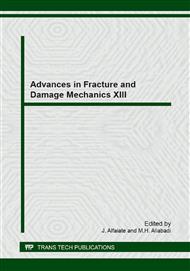p.433
p.437
p.441
p.445
p.449
p.453
p.457
p.461
p.465
The Behavior of Pseudo Strain-Hardening Cementitious Composite (PSH2C) Using Synthetic Fibers under Uniaxial Tensile Loading
Abstract:
The application of pseudo strain-hardening cement composites (PSH2C) to structural systems depends primarily on the tensile response of the materials, which is a direct function of fiber and matrix characteristics, the fiber content or volume fraction. In general, improved response of material is observed with an increase in the fiber volume fraction, as long as the fiber content does not impede mixing. This paper addresses the direct tensile response of pseudo strain hardening cement composites (PSH2C) reinforced with PET fibers, which belongs to a class of discontinuous short fiber reinforced cement based composites characterized by a strain hardening and multiple cracking responses under direct tensile loading. The variables are different types of fibers (PET, PET+PE, PET+PVA).
Info:
Periodical:
Pages:
449-452
Citation:
Online since:
September 2014
Authors:
Price:
Сopyright:
© 2015 Trans Tech Publications Ltd. All Rights Reserved
Share:
Citation:


